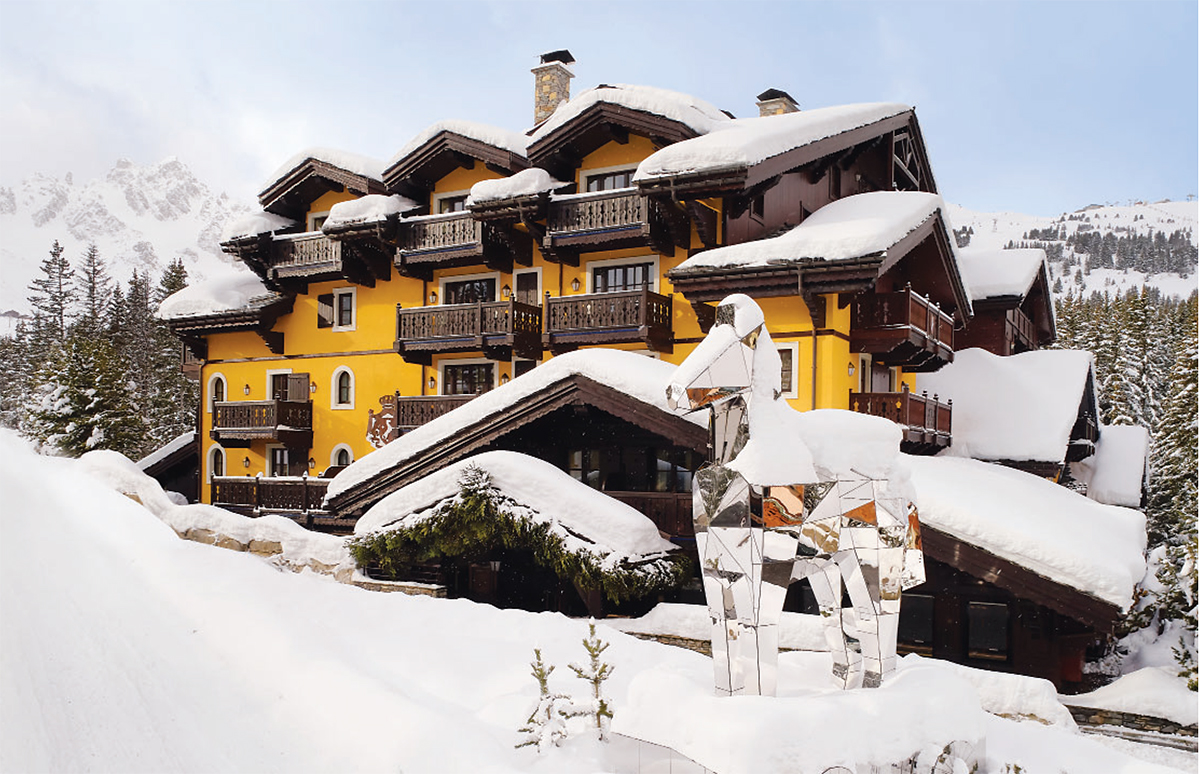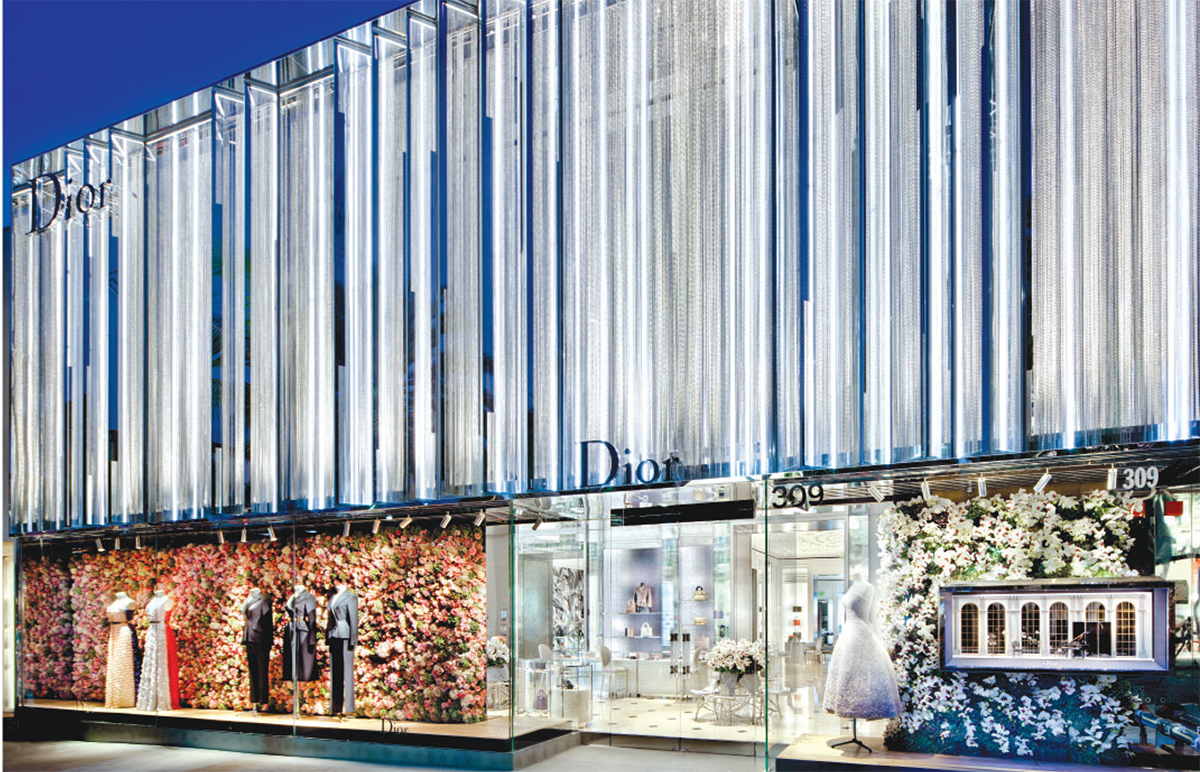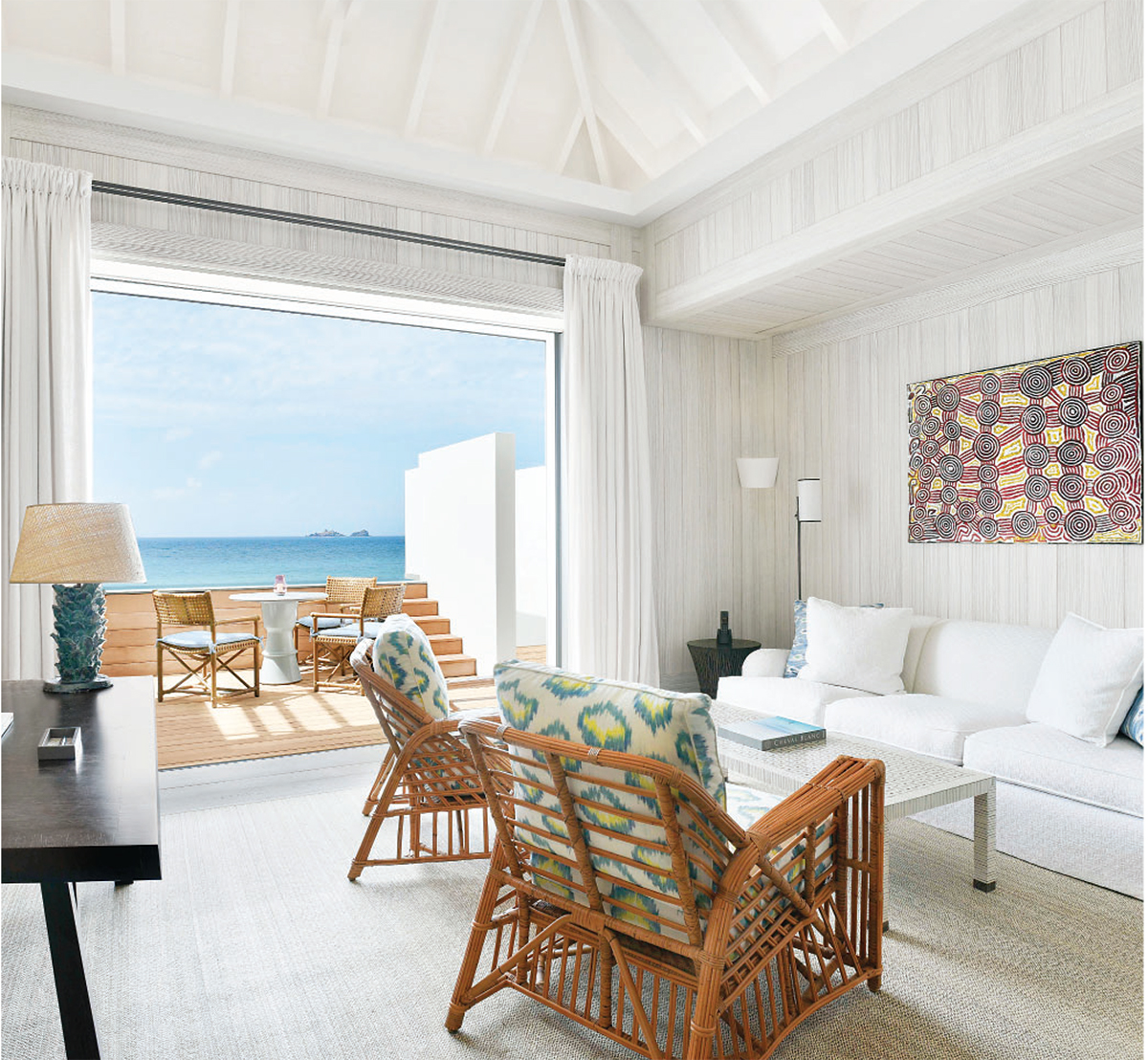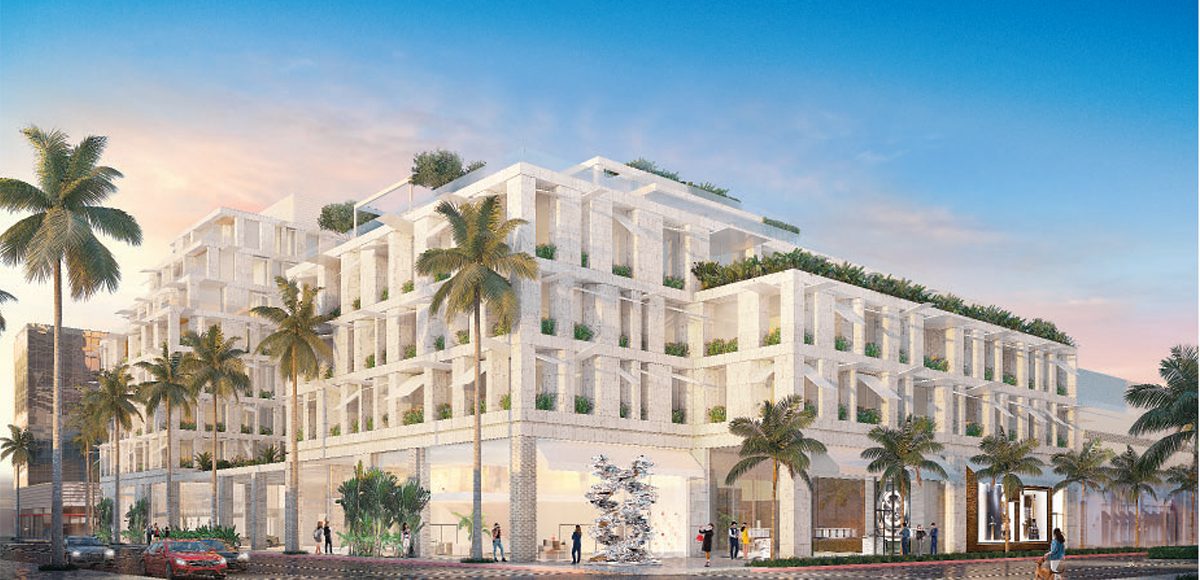The Beverly Hills Courier has obtained exclusive first details about the development plan submitted by LVMH for Cheval Blanc Beverly Hills. The ultra-luxury hospitality, retail and dining project is expected to open on Rodeo Drive in 2025. Plans call for an innovative, yet classic 115-guestroom bespoke hotel, as well as ground-floor LVMH retail establishments and exclusive dining venues. Additional features include rooftop pools, a private club and expansive penthouse space.
LVMH Moët Hennessy Louis Vuitton is the world leader in luxury, comprised of 75 Maisons in five key sectors of the luxury market. Its portfolio of one-of-a-kind Cheval Blanc properties is acclaimed for combining the French art of hospitality with uncompromising privacy, exclusivity and an intimate sense of place. Cheval Blanc Courchevel in the French Alps, Cheval Blanc Randheli in the Maldives, Cheval Blanc St-Barth Isle de France in the French West Indies and Cheval Blanc St-Tropez have transformed the concept of high-end hotels for the world’s most discerning guests. A Paris property is set to open this spring and additional projects are in the pipeline in London and Seychelles.
LVMH has now chosen Beverly Hills as the site of its first Cheval Blanc in the United States.
It is a testament to the company’s belief in Beverly Hills as one of the world’s premier locations, and in Rodeo Drive as its most exciting focal point. LVMH is a longtime stakeholder, taxpayer and employer on Rodeo Drive, all of which underscores a key factor distinguishing their proposal. This is not a case where the applicant is a developer interested in flipping the project once completed. LVMH plans to build and operate the property as the latest in its series of investments in Beverly Hills. Those investments are substantial. LVMH currently owns or leases 18 properties in the City, employing more than 240 people through brands such as Louis Vuitton, Christian Dior, Fendi, Marc Jacobs, Rimowa, Bulgari, Loro Piana, Hublot, Berluti and Sephora brands. By mid-2020, LVMH is expected to close on its acquisition of Tiffany.
Overview of Cheval Blanc Beverly Hills
The future Cheval Blanc Beverly Hills will occupy four contiguous parcels bordering Rodeo Drive, Little Santa Monica Boulevard and Beverly Drive. Namely: the former Brooks Brothers building which housed the popular “Louis Vuitton X Exhibition” in 2019; Celine Rodeo Drive; the former Paley Center for Media and the property at 449 N. Beverly Drive.
Over the next five years, the above- named parcels are set to transform into an impressive stone-clad structure designed to fit seamlessly into the existing landscape of Beverly Hills. Its principal facade will face Little Santa Monica Boulevard and an innovative pedestrian plaza with a custom art piece will energize the corner of Little Santa Monica and Rodeo Drive. A porte cochere with multi-level landscaping will provide access to the property, while the alleyway between Beverly and Rodeo Drives will become a new thoroughfare. And on the Beverly Drive-Little Santa Monica corner, a two-story dining venue will welcome hotel guests and residents alike.
Brand hallmarks of Cheval Blanc include small room count, exceptional food and beverage offerings, innovative spas and wellness programs and customized design and art concepts. In keeping with a boutique, residential approach, the brand does not offer banquet facilities, event facilities, or group business. Cheval Blanc Beverly Hills is expected to showcase those brand hallmarks, while imparting the unique imprint of its Beverly Hills setting.

Peter Marino Architect
LVMH has commissioned architect Peter Marino to design Cheval Blanc Beverly Hills. Known for his award-winning retail, residential, cultural, and hospitality projects worldwide, he has long-standing relationships with both the City and LVMH. He received his first Excellence in Design Award from the Architectural Commission of the City of Beverly Hills in 1994 and his most recent award from the City in 2015 for the adjacent Louis Vuitton building on Rodeo Drive. Marino’s work includes the Dior store and the Fendi store on Rodeo Drive, which received an American Institute of Architect’s Citation for Design.
“Our intention was to conceive a vibrant addition to the City of Beverly Hills and a new icon for both the City and Cheval Blanc,” Marino said. “Our approach started with the location and context, of Beverly Hills, resulting in an innovative, modern, Southern California design. Working with artists is an essential aspect of my work, and site-specific artworks are being commissioned for the new hotel, both inside and out.”
Marino has distinguished himself for integrating art within his designs, having commissioned over 300 site specific works for his projects. Unique artworks are set to play a central role in the design of Cheval Blanc Beverly Hills. Specially commissioned art pieces will be included throughout the interior and exterior of the hotel, including at the new pedestrian plaza.
“We are delighted to announce the first Cheval Blanc hotel in the U.S., destined for the heart of Beverly Hills. LVMH has a long and successful presence on Rodeo Drive and we look forward to expanding our role in the City with this exceptional new destination,” said Bernard Arnault, Chairman and CEO of LVMH. “Peter Marino has designed a magnificent hotel that will offer unrivaled hospitality, as well as dining and retail locations, and enhance Rodeo Drive’s reputation as an unparalleled luxury destination.”

LVMH has engaged local architect and planner Gruen Associates to work on the project. Gruen has extensive experience in Beverly Hills and has collaborated with Peter Marino on many award-winning projects within the Beverly Hills Business Triangle over the past decades.
Economic Effects
LVMH is positioning the project as a major economic driver that will reinforce Beverly Hills’ status as an iconic commercial destination. The company’s high-caliber restaurants and flagship retail destinations will enliven the entire business community. Moreover, the vibrant ground floor pedestrian space will complement the goals of the City’s BOLD Initiative year-round.
Cheval Blanc is also poised to deliver high-quality permanent jobs, and with them, specialized training in the key component of “Art de Recevoir” for which Cheval Blanc is famous. Along with bringing significant tax revenue each year, the hotel will also create hundreds of construction jobs.
And on the environmental front, LVMH has emphasized measures to embrace environmental sustainability. For example, the project is designed to achieve the rating of LEED Silver or better. Sustainability features will include electric vehicle charging stations, bicycle parking, provisions for rooftop solar collectors, and the recycling of at least 50 percent of demolition and construction materials.
The Process
The proposal submitted by LVMH to the City’s Planning Department sets a multi-year process in motion. As with other similar projects, it contemplates a General Plan amendment, a Specific Plan (which guides the implementation of the General Plan as amended) and a Development Agreement with the City.
Moving forward, the Planning Department staff will need time to review the application for completeness, and the City will then solicit bids from environmental consultants to be retained for the project under the City’s control.
The City is required to analyze the project under the California Environmental Quality Act, known as CEQA. Environmental review and public hearings take place during this time, and thanks to CEQA the process goes forward with a strong emphasis on transparency and responsiveness to community concerns. The community will be invited to participate in the environmental review process from the beginning, when the scope of the review is decided. The draft environmental impact report (EIR) will also be available for public review and comment, and the City is required to respond to those comments prior to holding public hearings on the project. In fact, it is obligated to identify any significant environmental impacts and all feasible mitigation measures in the EIR.
For its part, LVMH has stated that it is committed to fostering a productive dialogue with neighbors and other stakeholders about the project and intends to pursue the necessary approvals in an inclusive and transparent manner.
“Our project team is committed to ensuring that the hotel integrates naturally with the surrounding community, with the goal of being a great neighbor for the entire City. To achieve this, we are taking steps to engage directly with neighbors and other stakeholders to foster a productive dialogue about the project,” said Anish Melwani, Chairman and CEO of LVMH, Inc. in the U.S.
He added: “We wish to extend our deep thanks to everyone at the City of Beverly Hills for their valuable feedback on our proposal.”
This City-led environmental review and approval process is expected to take approximately 18 months.
General Plan Amendment
The EIR will take into account the request by LVMH for a General Plan amendment to allow for the project’s height. Such requests are not uncommon for projects of this scope. While the Business Triangle district is characterized by low rise retail in the City’s General Plan and Zoning Code, there are exceptions contemplated for certain projects. Strategic locations known as “anchor locations” are considered appropriate candidates for an amendment if they provide for greater intensity of use that results in a synergistic revitalization of the neighborhood.
LVMH believes that its proposed project meets the definition of such an anchor location. It will serve as an inner gateway to the northern end of Rodeo Drive, on the border of the Business Triangle. It will benefit other nearby businesses by increasing foot traffic in the area, raising the Business Triangle’s global profile and serving as a modern counterweight at one end of the City’s most famous destinations.
LVMH has also requested a Development Agreement with the City, another typical step in projects of this nature. The purpose of such agreements is to vest the project’s approvals for the duration of the multi-year construction process to protect LVMH’s considerable investment. California law provides that cities can negotiate Development Agreements that lock in vested rights for a proposed project. In doing so, the City can negotiate for benefits that will inure directly to the general fund. LVMH is expected to engage with the City in separate business negotiations for the Development Agreement.
Still to come after completion of the General Plan Amendment, Final EIR and Development Agreement will be Architectural Commission approval of the final design. This stage will contemplate specific details of the project, down to the type of stone used on the external façade. LVMH will then pull the requisite building permits, with groundbreaking still a few years away, at the earliest.
Those interested in reviewing the submitted plans and application materials for Cheval Blanc Beverly Hills may make a request for public inspection with the Beverly Hills Planning Department. The Beverly Hills Courier will continue to follow the progress of this and other notable projects affecting the landscape of the City.

Image Credits: Peter Marino Architect; Cheval Blanc/F. Nannini, V. Mati; Peter Marino Architect/ Richard Cardan, Courtesy Dior







